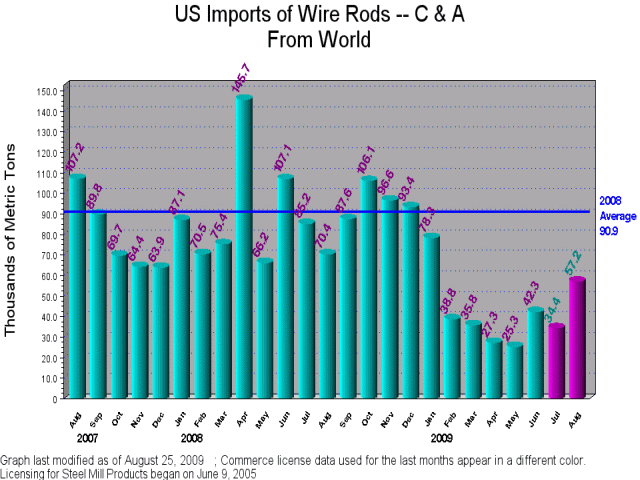While the pricing trend for US wire rod remains slightly up, the ongoing weak demand and possibility of the return of aggressive import offers remain areas of concern for domestic producers.
Over the last couple months, rising raw material costs, drastically reduced US production, and absence of imports have helped US wire rod producers finally put an end to the downward price trend that had plagued the market since the fourth quarter of last year. US rod mills have even been able inch their prices up in several small increments since the end of June. Since last week, US domestic low carbon wire rod offers have generally remained at a range of $28.00 cwt. to $29.00 cwt. ($617 /mt to $639 /mt or $560 /nt to $580 /nt) ex-mill, which represents an increase of about $3.00 cwt. ($66 /mt or $60 /nt) since the market reached a yearly low of $25.00 cwt. in April. Still, amid the depressed economic conditions, neither demand nor pricing for US rod are in the midst of a major recovery, and it remains the case that large buyers, depending on region, can still negotiate offers that are up to $1.00 cwt. ($22 /mt or $20 /nt) below the going range. Furthermore, if imports start to rise again or scrap prices start to fall, the US rod market could be at risk of losing the small amount of progress it has made so far.
On the raw materials side, US scrap prices are currently expected to be up in September, which should help US rod mills push through their $10/nt September price hike and possibly lead them to announce another increase for October. However, some recent slumping of international scrap buying activity combined with the coming fourth quarter seasonal slowdown could potentially cause scrap prices to retreat again by year-end.
Then again, rising scrap prices are not the only factor which have allowed US wire rod prices to rise. Tight supplies – caused by domestic mills running at severely reduced capacities and two major US mills exiting the market altogether, along with the lack of import competition – are the major reason behind US wire rod's small but steady Q3 recovery. With less players in the market, the US rod mills left standing have been able to get more bookings and thus regain price control.
Buyers are also concerned about the tight supplies, particularly on the East Coast, where production has decreased significantly due to the closure of Gerdau Ameristeel's Perth Amboy, New Jersey mill and ArcelorMittal's Georgetown, South Carolina mill. Concerns over supplies have prompted some hedge buying from buyers seeking to protect themselves from potential price hikes in the future. But with end-use demand remaining mostly flat (see US wire market recovery still lagging behind wire rod published by SteelOrbis on August 24), and some of the recent “hedge buying” including import tons as well, the domestic rod market may have a difficult time maintaining its upward price momentum unless demand starts to show some serious improvement.
There is still little US interest in import rod offers, as virtually the only source offering somewhat competitive low carbon materials, Turkey, is still too high-priced to compete very well with domestic offers. However, due to an increase in hedge buying activity in recent months as domestic prices have improved, wire rod import volumes rose rather significantly in August, led by a major increase in tonnage from Turkey.
Import prices from Turkey are still trending slightly up due to high raw material costs, and there are still not many US orders being booked. Though absent now, China is the bigger potential import source for the US rod market. China’s rod production is massive and its markets have been slowing down somewhat recently, causing Chinese domestic prices to dip slightly. Although it has remained dormant this year due to export restrictions and a strong domestic market, many fear that if China's market were to weaken further, the US market could be flooded again by Chinese rods.
For now, Chinese offers (of boron added material, which are not subject to an export tax like carbon rod) remain priced out of the US market, though there is concern that these prices have been coming down somewhat in recent weeks, edging closer to the Turkish price. Turkish mesh-quality rod offers to the US have remained since last week at a range of $26.00 cwt. to $27.00 cwt. ($573 /mt to $595 /mt or $520 /nt to $540 /nt) duty-paid, FOB loaded truck in US Gulf ports. Mills in Turkey are still generally taking a bullish stance and have tried to raise prices above this level, but traders report that customers have little interest in paying more than the abovementioned level as some buyers can still procure domestic rod at as low as $27.00 cwt. ex-mill.
Import statistics from the US DOC show that wire rod imports rose from 32,075 mt (based on preliminary census data) to 57,211 mt in August so far (based on license data collected through August 25). The largest import rod source in August was Turkey, with 19,437 mt (from 0 mt in July), followed by Canada (12,121 mt) and Brazil (9,201 mt).
| Item | Spot price for US buyers | From Last Week | From Last Month | Pricing Trend | Comments |
| US domestic low carbon wire rod | $28.50 cwt. | No change | up $1.00 cwt. ($22/mt) | | ex-US mill |
| Import mesh-quality wire rod (Turkish origin) | $26.50 cwt. | No change | up $1.00 cwt. ($22/mt) | | FOB loaded truck in US Gulf ports |
